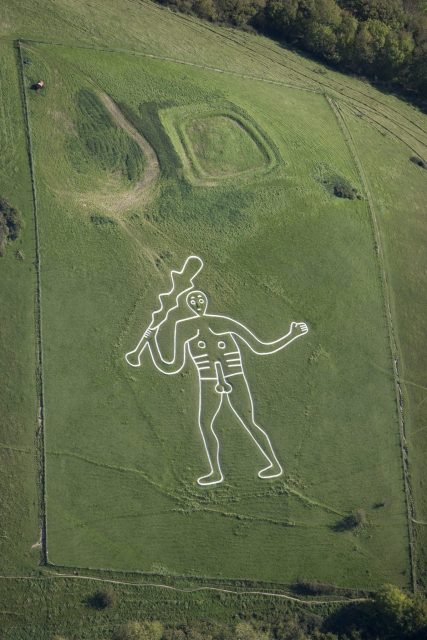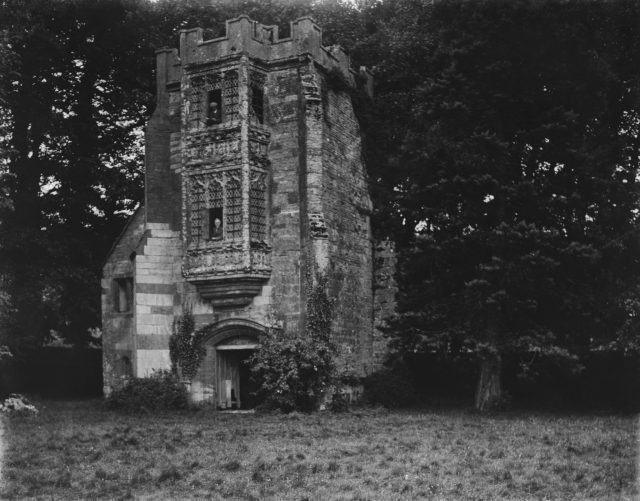The famous Cerne Giant’s origins have recently been revealed, and the date baffled scientists, historians, and archeologists alike.
The results of tests done by The National Trust and the University of Gloucestershire reveal that the Giant is neither of prehistoric or Roman times, as previously believed, but of the late Saxon Era.

What is The Cerne Giant?
The Cerne Giant is a humanoid hill figure near the village of Cerne Abbas in Dorset England. Standing 55 meters (180 feet) high, The Cerne Giant is the U.K.’s largest chalk hill figure.
Depicting a man holding a giant club, the Cerne Giant was originally created by people doffing a trench and then filling the outline with white pounded chalk. The first historical mention of the Cerne Giant was from 1694, found in church records. Since then, the Giant’s origins have been baffling people around the world.

Early theories on the Cerne Giant
Historians and archeologists have debated for decades about the true origin of the Cerne Giant. Although the first record of the Cerne Giant appeared in 1694, it was mysteriously absent from a 1617 survey of the area done by John Norden. This could possibly suggest that the Giant appeared sometime between 1617 and 1694, but that seems doubtful considering the lack of evidence of its creation.
Throughout the 18th century, drawings and other depictions of the Giant began to circulate. As the Giant became more well known, more and more people sought to figure out its origin story. An article appearing in The Gentleman’s Magazine from 1764 suggested that the Giant had been around at that point for “more than a thousand years.” Others believed the Giant to resemble Hercules, and therefore was created sometime after the Roman occupation in Britain, starting in 43AD.
Other theories suggest the Giant is a parody caricature of Oliver Cromwell from the time of the English Civil War. Under this theory, the club has been to be seen as representative of Cromwell’s military rule while the erected phallus mocks Cromwell’s strict Puritan values.

Recent scientific analysis of the Cerne Giant
Starting in 2020, The National Trust, the University of Gloucestershire, Allen Environmental Archeology, and the Pratt Bequest joined together to figure out the true origins of The Cerne Abbas Giant. Using a process called Optically Stimulated Luminescence (OSL), the team analyzed individual grains of sand in the sediment to figure out when they were last exposed to sunlight.
The result from this analysis was shocking and unexpected. Rather than being from prehistoric times or the Roman era, the Cerne Giant is most likely from the late Saxon period.
The researchers involved in this project dug into the deepest parts of the giant — the soles of its feet and the crooks of its elbows which go down one meter below the surface of the earth. The oldest date from the soil is AD 700 to 1100, and researchers are now certain that the Giant could not have been created before these dates.

Independent geoarchaeologist Mike Allen, whose research on microscopic snails was an integral part of this analysis, states this result was surprising to everyone: “This was not what was expected. Many archeologists and historians thought he was prehistoric or post-medieval, but not medieval. Everyone was wrong, and that makes these results even more exciting.”
Previously, analysis of snail shells found at the site suggested that the Giant had been a creation of the 13th or 14th centuries. The National Trust’s analysis now moves the creation date up by three centuries.
So what could the Giant really be?
Although there is now a more definitive date associated with the Cerne Giant, the jury is still out on why he was created. The most plausible theory seems to be that the Cerne Giant is associated somehow with the early Anglo-Saxon god known as “Heil” or “Helith.”
According to National Trust archaeologist Martin Papworth, these new dates place the Giant in a dramatic part of Cerne history. Papworth believes there is a chance that the Giant could hold some sort of pagan symbolism.
The Cerne Abbey was founded in 987 AD, and some have proposed that this Abbey was originally built to convert those who worshipped the Saxon god “Heil” or “Helith” to Christianity. Perhaps the Cerne Giant is a depiction of this Anglo-Saxon deity, and the Abbey was established to “purify” a pagan place.

However, questions have been posed as to why the first mention of the Giant came in 1694 if its origins are in the 10th century. Papworth’s theory is that perhaps the Giant was created in the late Saxon period but was at some point neglected and eventually forgotten. This theory could explain why the Giant was absent from John Norden’s 1617 survey and Tudor records.
However, as the National Trust report asks, why would a rich and famous abbey only a few yards away commission or sanction a naked man carved in chalk on the hillside? Unfortunately, we may never know the answer to that question.

More from us: Mary Queen Of Scots’ Gold Rosary Stolen In Heartbreaking Raid
Another possibility of what the Giant represents is an act of resistance. Alison Sheridan, a freelance archeological consultant in Edinburgh, suggests that it could be an act of defiance against the Abbey. Carving a huge, crude depiction of a pagan god in such close proximity to a Christian Abbey is definitely a defiant act if this was the case.
Whatever the true reason for creating the Cerne Giant may be, one thing remains the same — he certainly is a unique attraction that now has a birthday associated with him.
